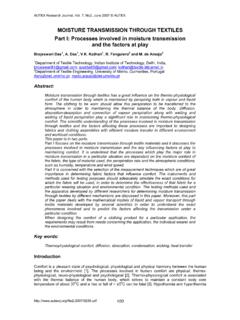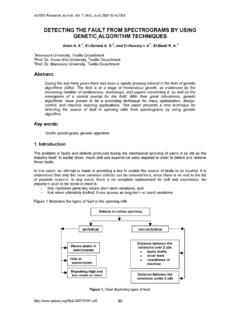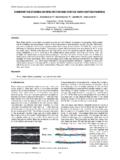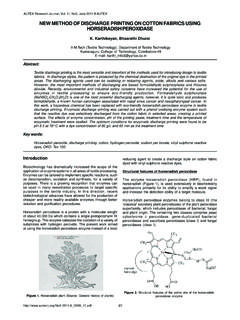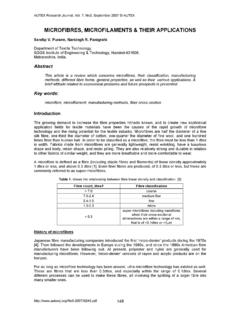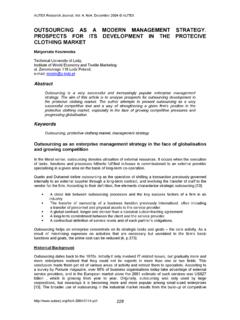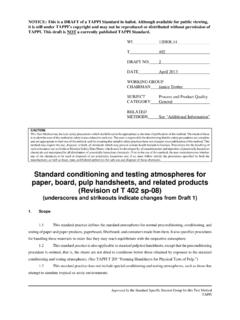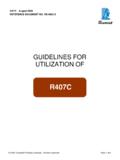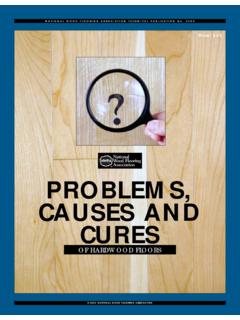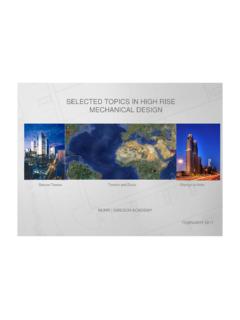Transcription of THE EFFECT OF LOOP LENGTH AND YARN LINEAR …
1 AUTEX Research Journal, Vol. 11, No4, December 2011 EFFECT OF LOOP LENGTH AND YARN LINEAR DENSITY ON THE THERMALPROPERTIES OF BAMBOO KNITTED FABRICP rakash Chidambaram1, Ramakrishnan Govind2, Koushik Chandramouli Venkataraman11 Department of Fashion Technology, Sona College of Technology, Salem 636005, India,E-mail: Department of Fashion Technology, Kumaraguru College of Technology, Coimbatore 641049, India,E-mail: this work, the thermal comfort properties of bamboo knitted fabrics have been studied in relation to looplength and yarn LINEAR density. The objective was to determine the influence of fabric factors such as loop lengthand the constituent yarn LINEAR density on the fabric properties such as air permeability, thermal conductivity,thermal resistance and relative water vapour permeability.
2 Yarns with LINEAR densities of 20s Ne, 25s Ne, 30s Newith the same twist levels were used to construct the fabrics of single jersey structure with loop lengths of mm, mm and mm. The anticipated increase in air permeability and relative water-vapour permeability with adecrease in yarn LINEAR density and increase in loop LENGTH was observed. In general, the thermal conductivityand thermal resistance tended to increase with the constituent yarn LINEAR density but decreased with an increasein loop words:Thermal comfort, yarn LINEAR density, air-permeability, water-vapour permeability, thermal conductivity, of the most important aspects of clothing is like thermal resistance, air permeability, watervapour permeability and liquid water permeability are criticalfor the thermal comfort of a clothed body.
3 Comfort plays a vitalrole in the selection of apparel. It is considered as afundamental property when a clothing product is comfort provided by clothing depends on several of them is thermal comfort, other factors include softness,flexibility, moisture diffusion, etc. The thermal comfort propertiesof textile materials have come into sharp focus in the textileresearch work of recent times. Properties like thermalresistance, thermal conductivity and thermal absorptivity areinfluenced by fabric properties like structure, density, humidity,material type and properties of fibres, type of weave, surfacetreatment, finish and compressibility, air permeability,surrounding temperature and the like.
4 Thermal comfortproperties of textile fabrics are actually influenced by the gamutof fibre, yarn and fabric properties. Fibre type, spinningtechnology, yarn LINEAR density, yarn twist, yarn hairiness, fabricthickness, fabric cover factor, fabric porosity and finish are majorfactors that determine the comfort properties of fabrics [1].The last few years have witnessed a growing interest in knittedfabrics due to their simple production techniques, low cost,high levels of clothing comfort and wide product range. Knittingis a process of fabric formation that involves the inter-loopingof yarn in a series of connected loops by means of fabrics are known to possess excellent comfortproperties.
5 They not only allow for stretching and ease ofmovement, but they also have good handling characteristicsand facilitate the easy transmission of water vapour from thebody. These attributes make knitted fabrics the commonlypreferred choice for sportswear, casual wear and structures offer several advantages. Physically, theypresent properties of comfort such as high stretch and elasticity,a snugness of fit to body shape, they are soft and pleasing totouch, offer a feeling of freshness and the like. Knitted fabricshave therefore long been preferred as fabrics in many kinds ofclothing.
6 Efforts have been made to make knitted fabrics morecomfortable by incorporating different fibres, altering yarnparameters, like twist, bulk, count, and finishing treatments,and knitting factors, like stitch LENGTH , CPI, WPI and fabric weight,and by adopting new or different finishes [2].In today s context, naturally renewable resources areincreasingly being sought owing to man s commitment toprotect nature. Chemical processes are being devised toproduce new biodegradable materials. Such materials cansuccessfully replace or improve the existing artificial or naturalmaterials.
7 Bamboo fibre is a regenerated cellulose fibre, ofrelatively recent origin, produced from the bamboo is an important forest biomass resource [3]. Bambootextile products have a host of incredible properties. It isbreathable, cool and extremely soft; it has a pleasant lustre, itrapidly absorbs water and is antibacterial. Yarns of bamboofibre provide the desirable properties of high absorbency,antimicrobial behaviour and result in a soft feel in textiles andmade ups [4]. It is also very hygroscopic, absorbing more waterthan other conventional fibres such as cotton and most prominent attribute of bamboo material is itsremarkable ability to breathe and its inherent coolness.
8 Thetransverse section of bamboo fibre is predominantly filled withinnumerable micro-gaps and micro-holes, a characteristic thatconfers to the fibre enhanced moisture absorption andventilation. Intimate clothing like sweaters and bathing suits,and household textiles such as blankets and towels areincreasingly being made from bamboo material. Bamboo-fibreclothing products display good water absorption and arecomfortable, they have a pleasing lustre and are bright in colour[5].Extensive research has been carried out to investigate thethermal comfort behaviour of knitted fabrics [3-7].
9 Oglakciogluand Marmarali [8] studied the thermal properties of cotton and AUTEX Research Journal, Vol. 11, No4, December 2011 basic knitted structures and found that each knittedstructure tends to show quite different thermal comfortproperties. Anand and Rebenciuc [9] concluded that fabricstructure and stitch density influence thermal resistance,thermal absorptivity and relative water vapour permeabilityproperties. Ozdil et al. [10] found that while the thermalresistance values decrease the water vapour permeabilityvalues increase with respect to yarn twist and yarn count.
10 Gunet al. [11] studied the properties of fabrics made from 50/50bamboo/cotton yarns and compared them with fabrics madefrom 50/50 viscose/cotton and 50/50 modal/cotton yarns. Thestudy compared the weight per unit area, thickness, burstingstrength, air permeability and pilling of the fabrics, and it wasfound that fabric weight, thickness and air permeability wasindependent of fibre paper investigated the influence of different loop lengthsand different yarn LINEAR densities in 100% bamboo knittedfabric on the thermal comfort properties of the fabrics.
